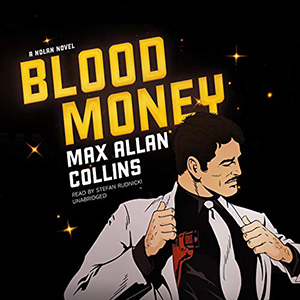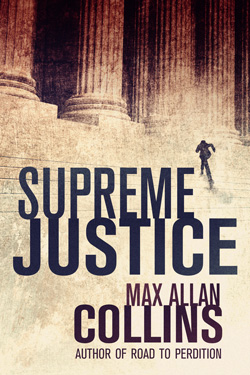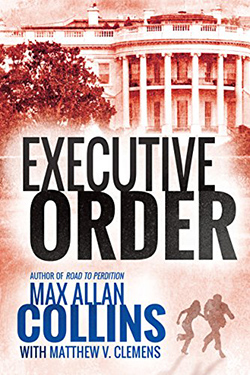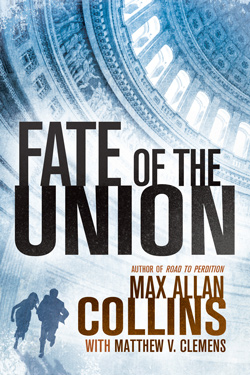I had not been given an advance look at the Noir Alley episode this weekend that had me guest-presenting with Eddie Muller the great film noir, Born to Kill (1947) from the James Gunn novel, Deadly Is the Female. During the shoot, Eddie and I had talked about both the film and the book for maybe forty minutes, and the TCM editors honed it down beautifully. I am very pleased, and if it turns up on You Tube, I’ll share it here.
God, I love it when I don’t stink up the place!
Skim Deep has been getting some lovely notices, I am pleased to say, including great Amazon reviews, and readers seem to be pleased either to see Nolan again or meet him for the first time.
But due out a week from today is the first-ever audio book of Blood Money, the second Nolan novel, read by the amazing Stefan Rudnicki. As you may know, Hard Case Crime is bringing out a new trade paperback edition of Two for the Money, collecting the first two Nolan novels – Bait Money and, again, Blood Money – on April 20.
The Edgar nominations are out, and Eliot Ness and the Butcher did not receive a Best Fact Crime nom, just as Scarface and the Untouchable did not in its year. It’s frustrating that this major work – I consider these two books joined at the hip – has not been better recognized; but I am confident that what my co-author, A. Brad Schwartz, and I accomplished will have a lasting place in true-crime literature.
Both Reincarnal & Other Dark Tales and Shoot the Moon (And More) are available in trade paperback(and of course Kindle) from Wolfpack. I talked about Reincarnal last week and spoke of my pleasure in having my short horror fiction collected in one place. I’m excited to see Shoot the Moon published as a novel and not as part of a collection. Originally it was featured in the now out-of-print Early Crimes, and the two short stories from that collection are still included, but moved to the back of the book as a bonus feature.
Shoot the Moon is a novel written fairly early in my career, but after Bait Money, Blood Money, No Cure for Death, The Baby Blue Rip-off and Quarry. So it’s not an early work in the sense of being formative or from my college days. The two short stories that serve as a bonus are, in fact, from my community college days, although one of them (“Public Servant”) was considered good enough years later to be included in a Lawrence Block-edited anthology (Opening Shots).
As I’ve mentioned earlier, Shoot the Moon is to the Donald E. Westlake comic crime novels as Bait Money is to the Richard Stark un-comic crime novels. My debt to Don Westlake, as an inspiration and mentor, is one I can never adequately repay.

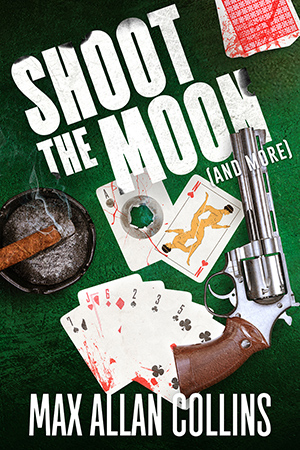
My son Nate encourages me to share behind-the-scenes stories and such about the writing life. So here I go….
Wolfpack is a very interesting outfit, because its publisher, Mike Bray, is something of a visionary, and its editor-in-chief Paul Bishop is a first-rate novelist himself who approaches publishing with an empathy and feel for his fellow writers.
I have been particularly pleased with the covers that have come out of Wolfpack, and yet a couple of problems turned up recently. As an example of the rampant political correctness that all creative people suffer these days, the cover of Reincarnal – which I love – was rejected for use in ads by Amazon. Fortunately, I’m told, ads for Facebook with that cover are still possible.
Apparently Reincarnal having a knife on its cover is the problem. I’ve run into this kind of thing before at several publishers, who haven’t wanted a gun on their covers. In one case, a publisher doing serial killer books – where the editor had me add a violent opening scene – did not allow guns or knives on their covers. Hey, I’m all for keeping guns off the floor of the House of Representatives and Senate – none of those people should be allowed around sharp objects – but on the covers of thrillers, horror novels and noir?
Who are we protecting with this prissy attitude, anyway?
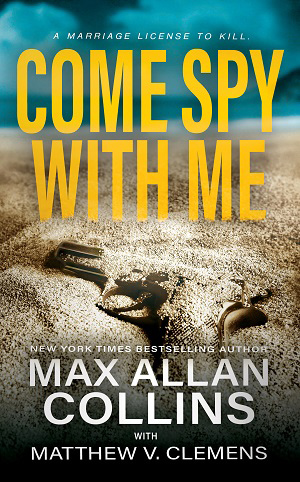
Conversely, the wonderful cover of Come Spy With Me has taken some heat for being too classy, too subtle. And it does have a gun on it! That gun is on a beach covered in sand, which anyone whose favorite word isn’t “Duh!” will tell you was meant to make you think of the protagonist, John Sand. It’s possible we’ll eventually do a second cover for that title, when the third Sand novel, To Live and Spy in Berlin, emerges – a book Matt Clemens and I are plotting, having delivered book two, Live Fast, Spy Hard recently.
Wolfpack’s bread-and-butter has been what I used to hear called “boy books” by editors both male and female. “Boy books” are westerns, techno-thrillers, male-lead thrillers, private eye novels and noir (the latter will come as a surprise to Christa Faust and Megan Abbott). Westerns and men’s adventure-type novels, including spy stuff, do very well at Wolfpack, and while my work is at least vaguely in the “boy book” vein, I am part of the publisher’s effort to expand into new publishing realms. And I salute them for that.
“How can I help?” I hear you saying.
You can buy Reincarnal, Shoot the Moon, and Come Spy With Me for a start, and all the other titles of mine Wolfpack has been good enough to foist upon you lucky people.
At fear of kissing up (well, I’m not that afraid), I will say that Wolfpack, Hard Case Crime, Titan and the emerging Neo-Text are publishers who are allowing me to explore the genres and characters I care about, both old and new, and God bless them for it. Every one of them has invested their faith in me and my work in a way that goes well beyond the standard publishing approach of, “Well, we’ll throw one or two of your titles out there and see how they do.”
Publishers, notoriously, have laid all the blame on the writer for the lack of success of a book. We writers are where the buck stops, and you might say, “Of course you are!” But the truth is publishers are not in the book-selling business, they are in the cover-selling business. Hey, if my books aren’t packaged correctly, it’s not my effing fault.
Now, I have to cop to having loved some covers that didn’t work in the marketplace, and having hated some that did. But it’s not my job to package the books. I am busy writing them. I am hard at work making Wheaties. What athlete goes on the box isn’t my choice or my fault, which means I can’t take full credit for how many boxes of Wheaties fly off the shelves.
Publishers usually ask for a writer’s input into the covers, and then ignore that input, often for good reason. Hard Case Crime sends me the cover before I’ve even written the book, so I can work the scene into the narrative, like the old pulp writers used to – I get a perverse pleasure out of that. Thomas & Mercer gave me a lot of input into the covers, and I love the results. Those books continue to sell briskly.
But here is my dream. An editor has a series that has received glowing reviews, a series that said editor considers first-rate, though with a small but dedicated reader base, if not enough to justify publishing any more books in that series. Rather than drop that series like something icky, why not consider a re-packaging approach, and take a hard look at the marketing that has (or hasn’t) gone into it, and give that series a book or two more, with a new cover and new marketing approach, before deciding its ultimate fate?
That never happens.
Keeping Nate Heller alive through five major publishing houses, with a fifth coming, over almost fifty years is a small miracle – no, a big miracle, speaking to my own stubbornness and my only-child inability to be told “no.”
And yet. Here is Nolan back in print. Here is Quarry not only back in print but with me writing, right now, the tenth new book (Quarry’s Blood) in a series started back up again in 2006 when the damned thing had been declared dead in 1976.
J. Kingston Pierce’s The Rap Sheet, hands down the best mystery site on the web, has an edition of his entertaining column-within-a-column “Bullet Points” that has a nice paragraph about the book I’m writing now (Quarry’s Blood) and Heller.
